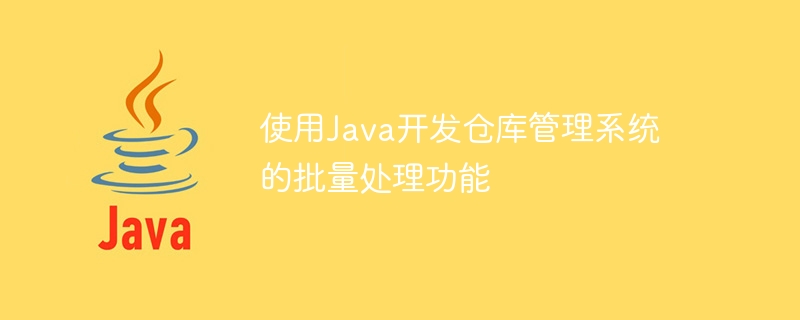

Title: Using Java to develop the batch processing function of the warehouse management system
In modern logistics management, warehouse management is a very important part. In order to improve the operational efficiency of the warehouse and reduce the workload of operators, it is particularly important to develop a warehouse management system with batch processing functions. This article will introduce how to use Java to develop a warehouse management system with batch processing capabilities, and attach corresponding code examples.
Java is a cross-platform object-oriented programming language. Its simplicity, reliability, and security make it an ideal choice for developing warehouse management systems. The following are the steps and sample code for developing the batch processing function of a warehouse management system using Java.
Step 1: Confirm requirements
Before starting development, you first need to clarify the specific requirements for batch processing. For example, we need to implement operations such as batch shipment, storage, and inventory of goods in the warehouse. Based on different needs, we can determine which functional modules need to be developed.
Step 2: Write the data model
In Java development, the data model is a very important part. By defining a reasonable data model, we can clearly represent various entities in the warehouse, such as commodities, warehouses, etc. The following is a code example for a commodity class:
public class Product {
private String id;
private String name;
private int quantity;
// 省略构造方法和getter、setter方法
}Step 3: Write warehouse management functions
According to needs, we can gradually write the functions of the warehouse management system according to the functional modules. Here, we take the batch outbound function as an example. The following is a code example of a simple batch outbound method:
public class WarehouseManager {
public void batchOutbound(List<Product> products) {
for (Product product : products) {
int availableQuantity = getProductQuantity(product.getId());
if (availableQuantity < product.getQuantity()) {
System.out.println("商品 " + product.getName() + " 库存不足!");
continue;
}
updateProductQuantity(product.getId(), availableQuantity - product.getQuantity());
}
}
}Step 4: Write user interface
In order to facilitate use, we need to write a user interface for the warehouse management system. The user interface can be implemented using Java's Swing framework or JavaFX framework. Here is a simple user interface example:
public class WarehouseManagementUI {
private WarehouseManager warehouseManager;
public WarehouseManagementUI(WarehouseManager warehouseManager) {
this.warehouseManager = warehouseManager;
}
// 省略界面布局和事件监听等代码
private void batchOutboundButtonClicked() {
// 获取用户选择的商品列表
List<Product> selectedProducts = getSelectedProducts();
// 调用仓库管理系统的批量出库方法
warehouseManager.batchOutbound(selectedProducts);
}
}Step 5: Test and Optimize
After development is completed, it needs to be tested and necessary optimizations made. Testing allows us to check that the system operates as expected and detect potential errors. Based on the test results, we can further optimize the code and improve the stability and performance of the warehouse management system.
To sum up, this article introduces how to use Java to develop a warehouse management system with batch processing capabilities, and provides corresponding code examples. Through reasonable demand analysis, writing data models, implementing corresponding functions and writing user interfaces, we can develop a practical warehouse management system, improve the operational efficiency of the warehouse and reduce the workload of operators. At the same time, we should also conduct testing and optimization to ensure system stability and performance. I hope this article can be helpful to Java developers when developing warehouse management systems.
The above is the detailed content of Using Java to develop batch processing functions of warehouse management systems. For more information, please follow other related articles on the PHP Chinese website!
